Traffic Control Systems Handbook: Chapter 13. Systems Management
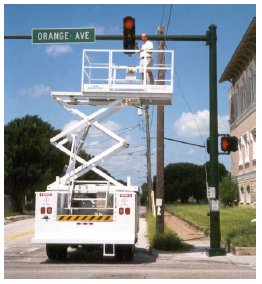
Figure 13-1. Traffic Signal Maintenance
13.1 Introduction
Increasing traffic demand and the need for reducing vehicle emissions and fuel consumption place new emphasis on management of traffic signal control systems. This will intensify with ITS deployment and more widely integrated operations.
Agencies responsible for traffic control system management have increasingly discovered that an install-and-operate, or a set-it-and-forget-it policy does not prove sufficient. The potential of the system(s) will only come to fruition with a policy of install, operate, and manage. Often, the benefits of traffic control systems are not being fully realized, largely as a result of inadequate management (1).
Managing traffic control systems includes four basic functional responsibilities:
- Teamwork,
- Operation,
- Maintenance, and
- Evaluation.
A traffic control system represents more than just a combination of hardware and software. The agency's organization and personnel become part and parcel of the system. For a traffic control system to realize its potential, the agency must have available:
- Technical skills to match the equipment, and
- Advanced management skills to assure that the entire system performs efficiently and effectively.
The flexibility and real-time evaluation capabilities of today's systems demand operational and managerial supervision. Successful traffic control systems show that such attention reaps rewards.
Signal systems are currently commonly being expanded to perform more general traffic management functions on surface streets. These functions include increased use of incident management and motorist information techniques (e.g. CCTV and changeable message signs), greater use of transit priority, and provision for emergency response and evacuation.
Traffic management becomes increasingly important because of growing requirements for reduced vehicle emissions and fuel consumption, which often requires mitigation on a region-wide basis.
In urban areas that have traffic control systems in two or more adjacent jurisdictions, all agencies must have a close working relationship to develop integrated traffic management. This includes coordination of traffic control system operation within the urban area and extends to the development of a central database for monitoring and improving operations and safety.
Reference 2 provides further details regarding management of traffic signal systems.
13.2 An Integrated System Management Concept
Effective traffic control systems require both intra-organizational and inter-organizational communications and teamwork. It proves essential to establish and maintain a team concept within an agency and among the involved governmental agencies within an urban area.
Within each agency, administrative, traffic management, design and maintenance personnel should remain involved in developing and operating the traffic control system. Enforcement personnel also should participate. These departments or organizations must work together and coordinate their activities. For example, operations, planning and enforcement personnel from each transportation related agency or department must coordinate to plan a reversible arterial lane. Similarly, a team approach applies to the administrators (e.g., city manager, director of public works, district engineer) from the agencies in an urban area.
For integrated systems, the development of both administrative and technical teams assures the required:
- Agency support,
- Administrative support and funding,
- Resource integration,
- Information exchange, and
- Coordinated design, operation and maintenance.
As defined by the Regional ITS Architecture, agencies in an urban area should exchange historical and real-time information on a continuing basis. Historical traffic information permits each agency to analyze trends for making operational changes. Real-time information includes traffic information from vehicle detectors and information on scheduled roadwork and special events. Sharing real-time information permits joint incident management by two or more agencies. It also provides for integrated communications with:
- Motorists,
- Commuters, and
- Commercial vehicle operators.
Region-wide coordination facilitates the achievement of certain traffic control system goals such as reducing vehicle emissions and delay and improving safety. This implies that multiple agencies within an urban area should design and develop systems on a broad traffic management basis to facilitate operations across jurisdictional boundaries. Carrying out operations and maintenance jointly on an agreed level of effort can also prove beneficial.
For example, the provision of signal priority for a regional transit system that may operate within the jurisdiction of a number of agencies responsible for traffic control systems may require a common set of equipment specifications, software and operating procedures for the affected portions of all of the traffic signal systems.
A team involving city, county, state, federal and public transportation agencies provides the base for developing an integrated system within the urban area. The team also needs representation from:
- Traffic operation agencies,
- The Metropolitan Planning Organization, and
- Law enforcement agencies.
Research results can improve traffic operations. In turn, integrated system development and operation often uncovers opportunities for further research (3).
Figure 13-2 shows the interdependence of the four functional responsibilities for effective system management. They share the following relationships:
- System operation requires proper system maintenance,
- Effective and efficient operation depends on evaluation results,
- System maintenance improves with a close working relationship among operational and maintenance personnel. Information on the nature and extent of equipment failures and anomalous operation usually originates from the system operators, and
- System evaluation depends on both operation and maintenance. Effective evaluation of a control strategy requires the system to operate as error-free as possible, with a minimum of hardware failures.
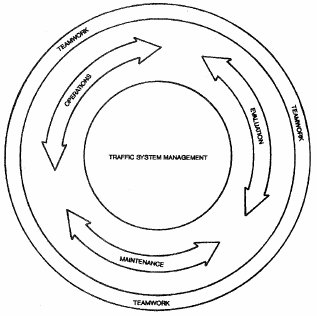
Figure 13-2. System Management Team Concept.
Considering the above interrelationships, management must organize personnel into a cohesive unit with upward mobility in order to retain skilled workers. The resulting management team assures that the traffic control system lives up to expectations and produces the greatest benefits for the motoring public.
13.3 Operations
Successful management of a traffic control system must achieve the end result of effective operations. This section deals with the following aspects of operations:
- Practical aspects,
- Typical work tasks, and
- Staffing requirements and organization.
Practical Aspects
Traffic control systems function in the most demanding of physical environments, subject to:
- Weather extremes,
- Wide temperature variations,
- Electrical noise and disturbances,
- Physical damage from vandals,
- Knockdowns from vehicles, and
- Vibration from nearby traffic.
Yet, the system must operate reliably and continuously, 24-hours each day of the year.
The system's operational environment proves even more demanding. Its daily operation remains in public view where it directly affects each user. This justifies intense monitoring of system performance to locate equipment malfunctions and to effect timely repair. Likewise, modifications in system performance must accommodate changes in traffic flows for:
- Optimum operating safety,
- Providing support to transit and paratransit services,
- Convenience of motorists, and
- Public acceptance of the system.
It often proves difficult to interrupt traffic control system operation. Degradation due to backup or fail-safe operation may be acceptable in emergencies but should not occur over an extended period. This emphasizes the need for highly reliable and well maintained equipment, and illustrates a basic principle which influences virtually all operational decisions. The system must work; it must work well; and it must work well virtually all the time, to adequately serve the public.
Control and Supervisory Periods
Because systems increasingly perform a greater number of control and monitoring functions, trends point towards an increase in periods during which the transportation management center is staffed. Some agencies may not continually staff the system during the entire operational period, but periodically monitor equipment malfunctions. During off-hours, a maintenance facility terminal commonly monitors equipment operation.
Most current traffic control systems enable on-line database changes. Similarly, many modern systems support software modification in the background.
Typical Work Tasks
Effective day-to-day operation of the control system requires a number of routine tasks and procedures to:
- Assure continuity of operation,
- Obtain and retain archival data,
- Assure security of the system database and software, and
- Ensure that the system is operated by authorized personnel.
Table 13-1 lists some suggested procedures and tasks.
| Task | Description |
|---|---|
| Maintain daily control log | Covers entire control period. Should include checklist of items and tasks
to remind each shift operator of responsibilities concerning duty routines
necessary for proper system operation. Entries in the log concerning system
functions or component failures serve:
The log can take handwritten or computer based form. |
| Maintain event log | Most computer based traffic systems provide a hard copy event log which
lists:
Preserve event log along with control log. The system often generates
the event log at midnight for the entire day. The system usually outputs
it on demand, at any time during the day. Some systems generate the event
log in hard copy on a continuing basis. |
| Maintain a ledger of timing plan modification | Maintain a ledger of timing plan modification The ledger should list:
A computer based ledger should be stored on disk |
Documentation is one of the most important operation tasks. Control system performance eventually reflects incomplete, incorrect, or non-existent documentation. Careful documentation control and distribution to the management team proves essential to successful system operation and maintenance. Document every change in:
- Software,
- Timing plans,
- Operational control parameters, and
- Hardware components.
Remember to update all copies of the documentation. Any team member, whether technician, programmer, engineer or systems manager should document changes.
Specific Operational Tasks for Intersection Control Systems
System Monitoring / Intervention
Most intersection traffic control systems have the capability of virtually unattended operation. The system automatically invokes predetermined schedules for:
- Time-of-day control,
- Conventional traffic responsive implementation of timing plans, or
- On-line generation of timing plans.
In normal operation, the system determines when signal timing changes occur based on:
- Time-of-day, or
- Processed traffic flow data.
The system status monitoring element then verifies proper execution of the timing on the street. Figure 13-3 shows this control loop for conventional systems.
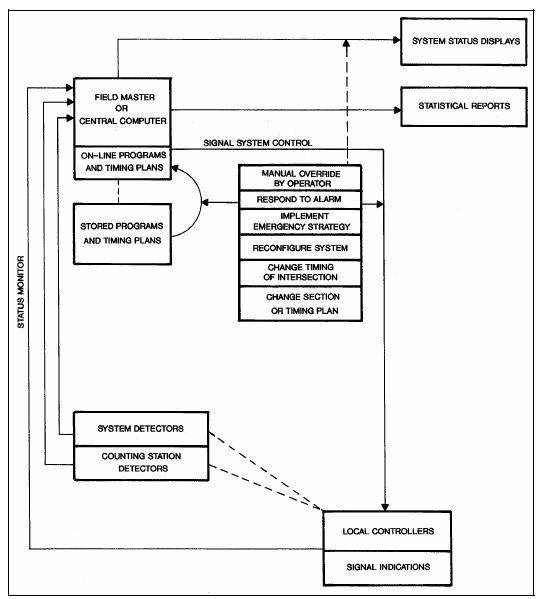
Figure 13-3. Typical Daily Control and Operations Architecture
- As shown in Figure 13-3, an operator can modify the normal automatic implementation of system configuration and timing through manual control.
Manual intervention typically responds to congestion or maintenance problems to accomplish the following:
- Remove a controller unit or other component, which shows repeated intermittent failures, from system control and dispatch maintenance personnel for repair,
- Return repaired controller units or other components to system control if this does not occur automatically after the repair,
- Implement an emergency configuration and / or timing strategy,
- Select an alternative timing plan,
- Change subsystem or system timing parameters on a temporary basis,
- Change individual intersection timing parameters on a temporary basis,
- Provide information to the motorist for systems having this capability, and
- Assist in incident management where the system provides this capability.
Data Collection and Analysis
In traffic control systems with limited data acquisition capabilities, the traffic engineer must rely on manually gathered field data and field observation to measure the effectiveness of implemented control strategies. Analysis of the data and observed field conditions provide the basis for modifying signal timing and plan scheduling. In normal operation, traffic control systems with more extensive data acquisition capability can automatically gather, tabulate and analyze significant amounts of traffic data. This tabulated and analyzed data produce measures of effectiveness (MOEs) for the system (see Section 3.11). Examples of data which generate MOEs include:
- Volume,
- Average speed,
- Occupancy,
- Queue lengths,
- Vehicle delay,
- Number of stops, and
- Travel time.
To easily analyze operational effectiveness, the system must assemble MOEs based on traffic data in usable form. To use the data effectively, personnel must understand what the respective printouts and graphics represent and how they relate to system control. The system should also aggregate link based MOEs for sections and the overall system.
Table 13-2 shows possible MOE formats for video display terminal (VDT) and hard copy and their usage.
|
Effective data collection and analysis establishes a structured procedure to schedule and assign a specific individual or team to review current MOEs and other data. This assures timely review of changing traffic patterns and the subsequent action needed to improve operation.
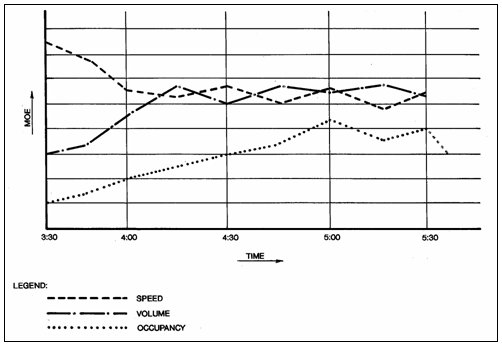
Figure 13-4. Typical Aggregate MOE Contour Timing Plan Graphic
System Modification and Updates
Traffic control systems require constant scrutiny to determine the need for operational changes. Examples of system upgrading include:
- Control strategy and timing modifications,
- Operating and control software updates, and
- Addition of new control features.
Modifications should include field review to ensure maximum effect. This includes queuing, utilization of storage space, proper progression, adequate cycle lengths, splits and offsets.
Each type of system modification has a different implementation timeframe.
In addition, the street system may undergo changes (e.g., reversible lanes, one-way pairs, intersection channelization, HOV lanes and bicycle lanes). Operational changes must take place with system upgrades and changes to the street system.
Updating System Timing
In the case of a traffic control system with few data acquisition features, the traffic engineer relies on field data acquired manually for timing plan updates and modifications. However, the engineer may use these data, together with the network's physical characteristics to run one of several available signal timing optimization programs for personal computers (PCs), such as PASSER, TRANSYT 7F and Synchro (see Section 3.8). Many traffic systems either directly support these programs or allow migration of the database from PCs to the traffic control system.
Figure 13-5 shows a typical flow chart for system modifications for non-adaptive traffic control systems. The engineer may have to collect turning movement counts to supplement system-derived data.
If a city or other agency does not have in-house personnel to develop and implement the needed plans and system timing, outside assistance can be obtained by engaging a consultant to perform this task. When a new system is being designed and installed, the design contract often includes the tasks of signal retiming and database preparation. These plans should be subsequently verified in the field, either by the consultant or by the operating agency.
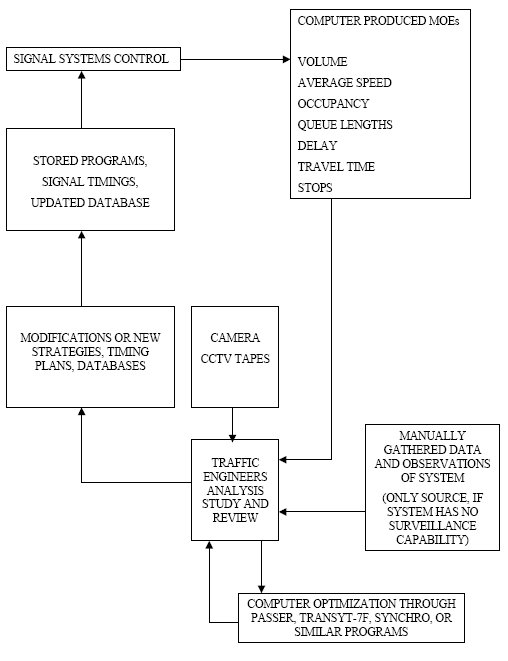
Figure 13-5. Typical Flow Chart for System Modification and Update for Conventional Traffic Control Systems
Changes in traffic flows create a need to implement signal timing changes. Factors that change traffic flow patterns include:
- Land use and population changes,
- Addition or deletion of signals,
- Development of major traffic generators,
- Street geometric changes,
- Operational changes in a corridor, such as one-way streets,
- Provision of traffic condition, route guidance or parking information, and
- Roadway construction.
Staffing Requirements and Organization
The expanded flexibility and ever increasing capabilities in contemporary control systems allow the agency extensive opportunities for staff involvement in traffic management. However, in many existing systems full use of the system's potential remains untapped due to staff limitations. To attain full system potential, consider the operating staff as much a part of the system as the computer itself.
Staffing Examples
The experience of currently operating systems proves valuable in assessing staffing needs for various types of traffic control systems. Table 8-5 gives staffing examples for existing traffic signal systems of various types and sizes.
Factors to Consider in Staffing
Regardless of control system size, the staffing organization requires the two basic skills shown in Table 13-3.
| Skill | Required Knowledge |
|---|---|
| Traffic Operations |
|
| Systems |
|
The skills will realize the full performance potential and capabilities of a control system and accommodate modifications. While very few agencies change on-line software in-house, they often develop or modify off-line spread sheet or database management system programs to process MOE data, for example. Some agencies rely on outside contracts for programming skills, as discussed later under software maintenance.
In assessing staffing needs, agencies must consider other factors such as the level of available resources. Do not assume that the sophistication and capabilities of a traffic control system can reduce the size and / or technical talent of the operations staff.
Table 13-4 describes other factors the agency should consider in assessing staffing requirements.
| Factor | Description |
|---|---|
| Assignments | In smaller traffic control systems, 1 or 2 qualified individuals can perform typical operational tasks. In larger systems, specific tasks must be identified and assigned to appropriately skilled personnel. Individual team members must know their specific responsibilities and relationships with other team members to assure proper system operation and updating. |
| Training |
Regular in-service and on-the-job training should be initiated as soon as practical after system implementation. Such a program provides continuity of operation as personnel changes occur and increases general interest in operations among team members. |
| Tours | Hosting visitors to the control center - usually most intense during the first 18 months. |
| Public relations | Developing public relations and citizen information programs through press releases, and compilation and printing of literature, based on the operation and performance of the control system |
| Shifts | Traffic control systems perform their functions around the clock, handling their more critical traffic loads during recurring control periods of higher demands. Most current operating systems provide on-site personnel for operations duties covering at least the period from the beginning of the morning peak to the end of evening peak. Smaller systems may limit staffing to peak periods only. Other systems are staffed on a 24-hour basis. Appropriate staffing periods can be determined only by experience with the system's operation over a reasonable period of time. Start with a 2-shift operation from approximately before the onset of the morning peak to the end of the evening peak. Supplement by some form of alarm response for the balance of each 24-hour period. Staff the system at least an hour before the morning peak to:
|
Organization
Organization of a traffic control system team should center around a nucleus of a functioning traffic operations section or division of a transportation department (or an equivalent section of a comparable entity). In that nucleus lies the tradition of effective traffic control: day-to-day and year-to-year practical experience. With this organizational structure, present operations personnel can absorb the new traffic control tool and, with proper training, use it to achieve performance improvements in the street network. Likewise, new operations personnel incorporated within the team structure can benefit from the practical experience of longer term personnel.
To assure close coordination and cooperation, it can prove advantageous for the same organization to have responsibility for both operations and maintenance. This logical tie-in of two essential system management functions improves the cohesion necessary for effective operations.
13.4 Maintenance
The successful performance of any operational traffic signal system depends on the commitment of the operating agency to an effective maintenance management program.
Maintenance has sometimes received insufficient emphasis in system management. Some agencies have erroneously presumed that high-technology systems possess fewer maintenance requirements and consequently underestimated budget and staffing needs for proper system maintenance. Similarly, agencies have failed to recognize the higher personnel skill levels required to maintain complex traffic control systems. This illustrates the need for cost tradeoff analyses during the design phase to identify techniques for reducing maintenance requirements.
An effective maintenance management program requires accurate record keeping and overall system configuration documentation including:
- Up-to-date timing plans,
- Database, and
- Software and hardware information.
Updating should be performed daily.
An effective maintenance management program relies on these records to:
- Predict future maintenance needs,
- Analyze costs, and
- Use for special purposes such as litigation.
The following paragraphs focus on the management aspects of traffic control system maintenance.
Types of Maintenance
Traffic control system maintenance activities are classified as:
- Functional,
- Hardware, and
- Software.
Functional
To achieve the full potential of traffic control systems, agencies should continually expand their effort on updating the database and optimizing signal timing plans as described earlier.
Computer-based traffic control systems use extensive databases, which include:
- System control input parameters,
- Operating thresholds,
- Functional characteristics, and
- Hardware characteristics.
Typical requirements for database updates include:
- Detector relocations,
- Subsystem reconfiguration,
- System expansion,
- Changes in controller types, and
- Changes in preemption routes.
Hardware
Traffic control system hardware maintenance generally falls into three categories (4):
- Remedial,
- Preventive, and
- Modification.
Remedial, usually commanding the highest priority, results from malfunctions and equipment failures, including emergency repair activity to restore operation. Most centrally controlled computer traffic systems and closed-loop systems incorporate software which can diagnose malfunctioning field components. During operating periods when such systems are not monitored by an operator, failure reports generated by such systems may be displayed at a terminal in the maintenance shop. Preventive maintenance includes work done at scheduled intervals to minimize the probability of failure. Modification or reconstruction becomes necessary when:
- A manufacturing / design flaw is identified, or
- Changes are needed to improve equipment characteristics.
Annual budgets must fund all three categories.
Sophisticated data communications, changeable message signs and CCTV increase maintenance and require more highly trained personnel. As technology advances, special skills may become necessary to provide adequate maintenance capability. The increased numbers of detectors in adaptive traffic control systems also require added maintenance.
Maintenance personnel should regularly check the operation of local controllers and detectors which do not operate as part of an interconnected system.
Scheduled maintenance includes such traditional activities as:
- Relamping, cleaning of signal heads, and
- Inspection of:
- Poles,
- Foundations,
- Wiring, and
- Pedestrian pushbuttons.
Software
Salwin (5) provides a detailed discussion of software maintenance. Software maintenance generally includes the following:
- Correction of errors and "bugs" not discovered during system acceptance and during the period the organization that installs the system is responsible for its warranty and maintenance.
- Modification or addition of features not previously included in the system. If the modifications may be accomplished by means of altering spreadsheets or database management programs, outside assistance may not be required.
If the agency has established the right to modify its software and documentation during system procurement, then either the system supplier or a third party may be used to modify and maintain the software and its documentation.
Results of Inadequate Maintenance
An inadequate maintenance program can have serious implications. For example, signal failures can directly impact accident potential. When accidents do occur, courts increasingly hold operating agencies liable if malfunctions were not corrected in a timely manner. This has resulted in increased emphasis on both maintenance and maintenance-record systems.
Maintenance also impacts the ability of a control system to optimally perform its functions. Failure of a single component may degrade system performance. For example, the real time selection and implementation of timing plans depends on input data from selected detectors. Failure of critical detectors could result in a less than optimum traffic control plan.
Maintenance deficiencies also result in the following types of equipment failure:
- Malfunction - Any event that impairs the operation of a control system without losing the display and sequencing of signal indications to all approaching traffic. Malfunctions include detector failures, loss of interconnected control, and other similar occurrences.
- Breakdown - Any event that causes a loss of signal indication to any or all phases or traffic approaches. Breakdowns include:
- Controller failures,
- Cable failures, and
- Loss of power.
- Reduced life - Lack of maintenance can also reduce equipment service life.
Staff Requirements
In planning maintenance staff for an advanced traffic control system, agencies must consider the:
- Impacts of the new system on overall maintenance activity, and
- Attendant maintenance skill level requirements.
Planning should assess:
- Present and projected maintenance skill level requirements,
- Present maintenance capability with respect to:
- Staffing,
- Equipment,
- Training and budget, and
- Projected workload impact associated with the new traffic control system.
Agencies may have difficulty:
- Finding competent specialists, and
- Paying competitive salaries for such personnel.
Agencies planning complex computer control systems should consider the alternative of contractual maintenance services. In cases where additional staff training and expansion prove appropriate, the training should be:
- Thorough,
- Both classroom and hands-on, and
- Intensive in troubleshooting and diagnostic techniques.
In an urban area, agencies can support each other by sharing maintenance resources on an on-going or as needed basis. For instance, one or more maintenance technicians could support systems in two nearby cities with the cities sharing salary and other costs.
The use of one type of hardware and one software package in systems increases personnel familiarity with the system reducing the time for:
- Troubleshooting,
- Training, and
- Equipment inventory.
Table 8-5 shows the number of personnel assigned to several operating traffic signal management systems.
13.5 Evaluation
Evaluation (see Figure 13-2) assesses performance levels of the design as well as the operations and maintenance functions. Evaluation should consider the effects on safety and traffic flow quality of new systems, control strategies, and other operational improvements with before and after measurements. The measures of effectiveness are those selected during system development.
Short-term evaluations assess the immediate effects of an operational strategy or timing change.
The agency should make a more in-depth evaluation of system operation and maintenance periodically (e.g., every one to three years) and when adding new locations and functions. This assures that the system configuration still addresses overall system needs.
Traffic control system improvements are usually proposed to decision-makers based on some forecast of the resulting benefits. Evaluation sustains the credibility of the traffic system and its staff. It also identifies ways to further increase benefits.
Techniques
Evaluation techniques based on traffic measurements usually prove more credible to decision makers than simulation results; thus, it is desirable to perform at least a portion of the evaluation in this way. If staff resources are insufficient, a qualified consultant can perform the evaluation.
Certain parameters such as volume may be obtainable from the traffic system. Caution must be exercised in using MOE such as delay, stops and speed from the traffic system as these MOE may contain estimation errors or may not truly represent conditions somewhat distant from the detector. Statistical techniques may estimate the quantity of data required to provide statistically significant results in the face of measurement error.
Simulation techniques may reduce the cost of evaluation, particularly for large systems. Credible evaluations require such simulations to be validated and, if necessary, calibrated against physical measurements for a portion of the system.
Before and After Measurements
Measurement of conditions before and after project implementation is perhaps the most common approach for evaluating improvements. This approach establishes the before measurement as the base and assumes that the after conditions represent the effect of the improvement.
This approach can prove susceptible to errors caused by time related factors, especially when measuring the effects over a long period. Factors that may influence conditions between the before and after measurements include:
- Population growth,
- Economic fluctuations,
- Completion of major traffic generators, or
- Other changes.
As indicators of change, before and after measurements cannot easily distinguish the effects of individual improvements made at the same time.
To some extent these issues can be mitigated using the traffic system itself as an evaluation tool. For example, evaluation can use the following procedure:
- After completion of construction, restore the database to pre-construction timing plans and control strategies,
- Measure before conditions,
- Implement new timing plans and strategies, and
- Measure after conditions.
The resulting shorter time period minimizes the effects of traffic demand changes during the evaluation period. Depending on the accuracy of the algorithms, system generated MOEs may provide cost effective evaluation data.
Even when long term demand changes do not impact evaluation, intermediate or short-term demand changes usually occur. Examples include demand variations resulting from:
- Seasonal effects,
- Holiday periods,
- Weather, and
- Special events.
The effects of improvements may be confounded when implementing two or more congestion reduction techniques concurrently. Examples include:
- Roadway improvements,
- One-way streets,
- Modified signal indications, and
- Revised timing patterns.
It may prove possible to evaluate in stages to emphasize the contribution of each technique.
Before and after studies can define specific test routes for evaluation. This approach is often selected when the evaluation uses floating vehicle measurements. Alternatively, intersection based measurements may be the basis for evaluation.
Sampling Considerations
The integrity of the sampling technique used for data collection critically impacts the level of precision expected in the evaluation. The level of precision associated with a before-and-after study depends on the:
- Importance of detecting a difference,
- Expected size of the difference, and
- Cost of the data collection activity.
In cases involving research, the importance of the project may warrant high precision. Studies involving relatively small before / after differences may also require high precision because a small scale study would prove inconclusive. Studies involving major changes at a particular location can tolerate lower precision. Carefully design the sampling procedure to measure the effects of the alternative strategies efficiently and accurately.
Box and Oppenlander (6) and other statistical methods references discuss techniques.
1. "Transportation Infrastructure: Benefits of Traffic Control Signal Systems Are Not Being Fully Realized." GAO Report GAO/RCED-94-105, March 1994.
2. Giblin, J., and Kraft, W. "Installation, Management and Maintenance." Institute of Transportation Engineers, Arlington, VA.
3. "Symposium on Integrated Traffic Management Systems." Transportation Research Circular No. 404, Transportation Research Board, Washington, DC, March 1993.
4. Baxter, D. "Contracting Maintenance for Traffic Signal Systems." New York State Department of Transportation, August 1984.
5. Salwin, A.E., "The Road to Successful ITS Software Acquisition: Volume 2: Overview and Themes." Mitretek, Federal Highway Administration Report FHWA-JPO-98-036, Washington DC, July 1998.
6. Box, P.C., and J.C. Oppenlander. "Manual of Traffic Engineering Studies." Institute of Transportation Engineers, Arlington, VA, 1983.